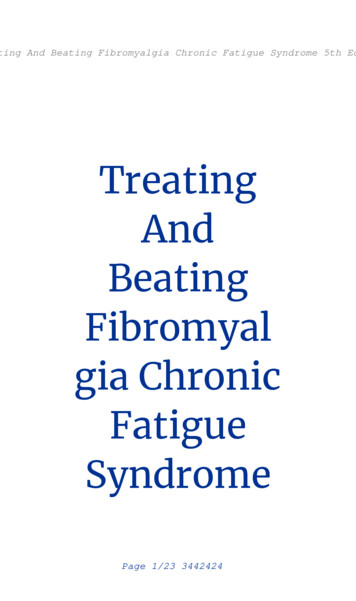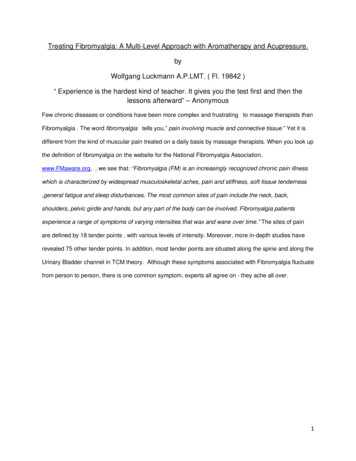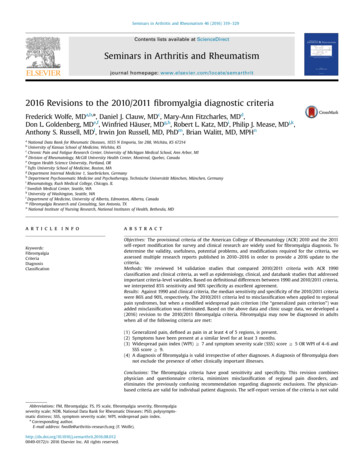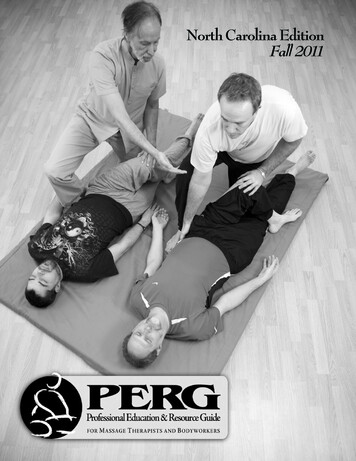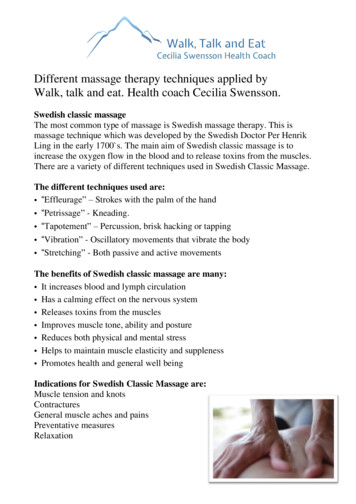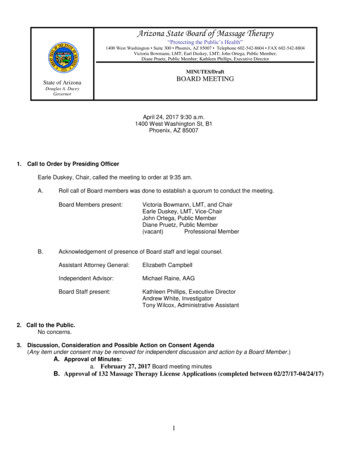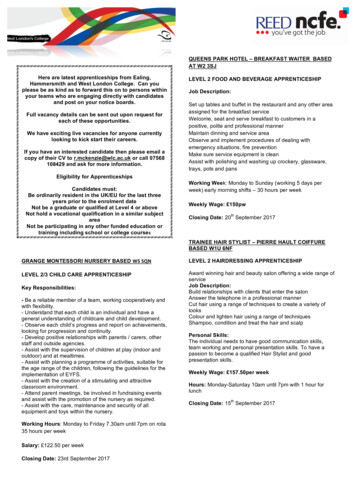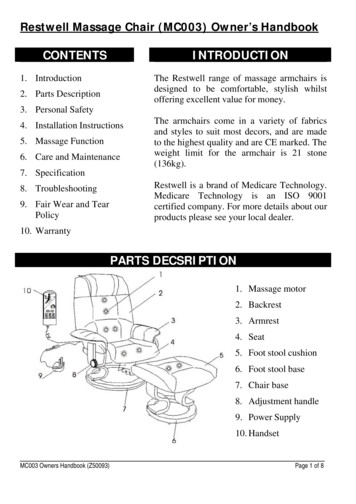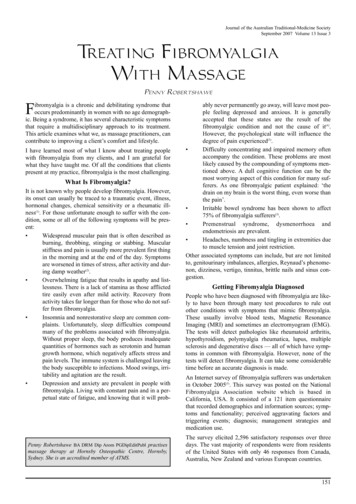
Transcription
Journal of the Australian Traditional-Medicine SocietySeptember 2007 Volume 13 Issue 3Treating FibromyalgiaWith MassagePenny Robertshaweibromyalgia is a chronic and debilitating syndrome thatoccurs predominantly in women with no age demographic. Being a syndrome, it has several characteristic symptomsthat require a multidisciplinary approach to its treatment.This article examines what we, as massage practitioners, cancontribute to improving a client’s comfort and lifestyle.FI have learned most of what I know about treating peoplewith fibromyalgia from my clients, and I am grateful forwhat they have taught me. Of all the conditions that clientspresent at my practice, fibromyalgia is the most challenging.What Is Fibromyalgia?It is not known why people develop fibromyalgia. However,its onset can usually be traced to a traumatic event, illness,hormonal changes, chemical sensitivity or a rheumatic illness(1). For those unfortunate enough to suffer with the condition, some or all of the following symptoms will be present: Widespread muscular pain that is often described asburning, throbbing, stinging or stabbing. Muscularstiffness and pain is usually more prevalent first thingin the morning and at the end of the day. Symptomsare worsened in times of stress, after activity and during damp weather(2). Overwhelming fatigue that results in apathy and listlessness. There is a lack of stamina as those afflictedtire easily even after mild activity. Recovery fromactivity takes far longer than for those who do not suffer from fibromyalgia. Insomnia and nonrestorative sleep are common complaints. Unfortunately, sleep difficulties compoundmany of the problems associated with fibromyalgia.Without proper sleep, the body produces inadequatequantities of hormones such as serotonin and humangrowth hormone, which negatively affects stress andpain levels. The immune system is challenged leavingthe body susceptible to infections. Mood swings, irritability and agitation are the result. Depression and anxiety are prevalent in people withfibromyalgia. Living with constant pain and in a perpetual state of fatigue, and knowing that it will prob-Penny Robertshawe BA DRM Dip Arom PGDipEditPubl practisesmassage therapy at Hornsby Osteopathic Centre, Hornsby,Sydney. She is an accredited member of ATMS.ably never permanently go away, will leave most people feeling depressed and anxious. It is generallyaccepted that these states are the result of thefibromyalgic condition and not the cause of it(4).However, the psychological state will influence thedegree of pain experienced(3). Difficulty concentrating and impaired memory oftenaccompany the condition. These problems are mostlikely caused by the compounding of symptoms mentioned above. A dull cognitive function can be themost worrying aspect of this condition for many sufferers. As one fibromyalgic patient explained: ‘thedrain on my brain is the worst thing, even worse thanthe pain’. Irritable bowel syndrome has been shown to affect75% of fibromyalgia sufferers(3). Premenstrual syndrome, dysmenorrhoea andendometriosis are prevalent. Headaches, numbness and tingling in extremities dueto muscle tension and joint restriction.Other associated symptoms can include, but are not limitedto, genitourinary imbalances, allergies, Reynaud’s phenomenon, dizziness, vertigo, tinnitus, brittle nails and sinus congestion.Getting Fibromyalgia DiagnosedPeople who have been diagnosed with fibromyalgia are likely to have been through many test procedures to rule outother conditions with symptoms that mimic fibromyalgia.These usually involve blood tests, Magnetic ResonanceImaging (MRI) and sometimes an electromyogram (EMG).The tests will detect pathologies like rheumatoid arthritis,hypothyroidism, polymyalgia rheumatica, lupus, multiplesclerosis and degenerative discs — all of which have symptoms in common with fibromyalgia. However, none of thetests will detect fibromyalgia. It can take some considerabletime before an accurate diagnosis is made.An Internet survey of fibromyalgia sufferers was undertakenin October 2005(5). This survey was posted on the NationalFibromyalgia Association website which is based inCalifornia, USA. It consisted of a 121 item questionnairethat recorded demographics and information sources; symptoms and functionality; perceived aggravating factors andtriggering events; diagnosis; management strategies andmedication use.The survey elicited 2,596 satisfactory responses over threedays. The vast majority of respondents were from residentsof the United States with only 46 responses from Canada,Australia, New Zealand and various European countries.151
Robertshawe P. Treating Fibromyalgia With Massage.Journal of the Australian Traditional-Medicine SocietySeptember 2007 Volume 13 Issue 3Respondents to the survey revealed that almost half of themhad consulted between four and six healthcare practitionersbefore they received their diagnosis. Almost 28% of respondents felt that their healthcare provider did not considerfibromyalgia to be a legitimate disorder.In 1990, the American College of Rheumatology developedcriteria by which fibromyalgia could be diagnosed(6). Theyestablished that widespread pain needed to have been present for at least three months prior to diagnosis. For the painto be considered widespread, it had to be experienced onboth sides of the body and in both the lower and upperregions with the waist being the line of division. In addition,a minimum of 11 out of 18 specific sites in the body had toreproduce ‘tender points’ on digital palpation (see Figure 1).What Is Happening To The Muscles?Like most people who suffer from muscular pain, the muscles of someone with fibromyalgia receive an inadequatesupply of energy from adenosine triphospate (ATP) and otherenergy phosphates. When energy from ATP is in short supply, some of the muscle fibres are unable to relax after contraction and the muscle remains in a shortened position. Ifthis pattern continues, tension gradually builds. Muscles andfascia become taught and lose elasticity. The supply of arterial blood flowing into the affected tissues is depleted thereby also depleting oxygen levels (ischemia) and causing muscular pain.Theories are still evolving about what else happens pathologically in people with fibromyalgia. However, biochemicalchanges have been found in the cerebrospinal fluid offibromyalgic clients. A series of metabolic imbalancesoccurs in people with long term, chronic muscular pain.They experience lower levels of serotonin, the neurotransmitter that is responsible for, among other things, diminishing pain and regulating sleep patterns. Substance P, anotherneurotransmitter that is responsible for triggering the painresponse, is increased(7).It is thought that the sympathetic nervous system infibromyalgic clients becomes disturbed in such a way as tofurther inhibit the ability for muscles to relax thereby causing further ischemia. This in turn results in even less serotonin and even more substance P production. In other words,the decreased pain relief and increased sensitivity to pain forthe person with fibromyalgia is amplified.Furthermore, the pathological picture is compounded by thesufferer’s unrestorative and disturbed sleep patterns. Withoutproper sleep, the body is unable to produce other neurotransmitters eg the body generates insufficient human growth hormone which helps to repair minor muscle damage(3).How Can We Distinguish BetweenTender Points And Trigger Points?Given the ‘tender points’ criteria described by the AmericanCollege of Rheumatology, it is clear that the chronic widespread muscular pain is what distinguishes fibromyalgiafrom other disorders. As one of my clients with fibromyalgiadescribed it: ‘it’s like having a period all over your body’.Myofascial trigger points are frequently present at the samesites as tender points and they can also cause chronic debilitating pain in several locations. The question as to whether ornot the two types of points are actually the same often arises. The answer is that there are defined differences betweenthe two conditions, but trigger points are frequently palpablein fibromyalgic clients (see Table gluteusgluteusmediusvvastusastus medialisvastustuslateralisralisFigure 1 Fibromyalgic tender points152
Robertshawe P. Treating Fibromyalgia With Massage.Journal of the Australian Traditional-Medicine SocietySeptember 2007 Volume 13 Issue 3Table 1: The table highlights some differences between fibromyalgic tender points and myofascial trigger points(2,3,8).Myofascial Trigger PointsFibromyalgic Tender PointsLocation of the point is localised and distinct.Location is more general.Pain usually has a specific referral pattern.Pain is described as burning, vague, diffuse, stinging and aching.On palpation, the muscle feels stringy, hard, rigid and warm.On palpation the muscles feel doughy and soft.Response to manual therapy is relatively quickand the problem can be resolved.Response to manual therapy is slow, requiring long termtreatment that may never bring full recovery.Affects males and females equally.Affects mostly females.Morning stiffness is not a trigger point symptom.Morning stiffness is a common complaint.Fatigue is not an associated condition.Fatigue is almost always present.Muscle endurance is not affected by trigger points.Muscle endurance is low so that those afflicted tire quickly.Exercise programs do not help this condition.Exercise programs have been shown to help this conditionif taken slowly and gradually.How Can Massage Help?People who suffer from fibromyalgia experience their symptoms differently. Each will present with a different combination of symptoms and in varying degrees. The primary motivation for seeking help from a massage therapist, however, isto find relief for their muscular pain.Two things to keep in mind when a fibromyalgic clientcomes for massage treatment is that their experience of thecondition will not be the same as another client, and theyhave ‘good days and bad days’.Massage can help relieve some of the pain experienced ifdone on a regular basis. It is important to keep in mind thelowered pain threshold of fibromyalgic clients — they willusually not be able to tolerate deep pressure. If it is their firstvisit to a massage therapist or their visits are infrequent, thebenefits of pain relief may not be experienced immediately.Occasionally, their condition is aggravated by an excessiverelease of metabolic waste products into the circulatory system.Many people with fibromyalgia, and other chronic pain conditions like hypothyroidism, find that lying prone for longperiods puts pressure on their thoracic cage leading to lowerback pain. They also find turning over on the massage tablevery difficult because their lower back ‘locks up’ making itinflexible. For this reason, it is best to minimise the timelying prone to no more than about 15 minutes depending onthe individual. The neck and shoulder regions can be treatedwith the client lying on their side in much the same way asyou would treat a pregnant woman with support under thetop flexed knee and under the head.The classical Swedish massage techniques of effleurage andpetrissage are effective for fibromyalgic clients. The strokesshould be used in a full body massage. The effleurage can beapplied superficially to induce relaxation initially, then bedeepened to stimulate circulation and identify areas of tension. The kneading and squeezing actions of petrissage alsostimulate circulation and warm and soften the tissues of boththe muscle and fascia.The gentle stretching of myofascial release techniques canprove to be a valuable tool when massaging a fibromyalgicclient. These techniques are painless and can help to free-upthe muscle beneath the fascia to give it more room for movement.Studies have been done using muscle energy techniques onfibromyalgic clients with positive results(4). There are different variations of muscle energy techniques, but one technique, post-isometric relaxation is gentle enough to use withmost fibromyalgic clients. It involves the practitioner bringing the antagonist to the affected muscle into a contractedposition just below the resistance barrier. The practitionerthen asks the client to push against their resistance using only20% of their strength for 10 seconds. The client then stopspushing and takes a deep breath after which the practitionergently stretches the muscle to its new point of just beingbelow the resistance barrier. This process can be repeatedtwo or three times.The benefit of using muscle energy techniques is that shortened muscles are lengthened by inhibiting the stretch reflex.The stretch reflex is the point at which resistance occurs.Muscle energy techniques overcome this reflex and take themuscle to a new limit.What Can A Client Expect?As with other aspects of this condition, opinions aboutwhether or not a client can expect future full recovery arevaried. Massage therapy alone, even if done frequently andregularly, is unlikely to bring long lasting relief. However, atoning down of pain and anxiety symptoms can be achievedwith regular treatment, particularly if combined with othertherapies such as acupuncture and naturopathy that aim toimprove the body’s capacity to heal.One of the problems with treating someone with fibromyalgia is that, for many, their syndrome has left them so debilitated that they are unable to cope with working in a full-timejob. They have probably spent a lot of time and money ontrying to diagnose, manage and treat their condition.Financial resources are often strained.153
Journal of the Australian Traditional-Medicine SocietySeptember 2007 Volume 13 Issue 3There is a long period of readjustment that requires thesepeople, who all too often have lead busy lives before developing fibromyalgia, to limit their expectations. No longerhaving the energy to physically take on many of the thingsthey could do before is only one aspect of the problem.Mental and emotional adjustments have to be made as well.Relationships undergo challenges as friends and family needto come to terms with the new limits that fibromyalgicclients have to set.For fibromyalgic clients particularly, it is important to givethem some techniques and strategies that they can use forself healing such as self massage techniques and possibly alight exercise program. By passing some of the responsibility for healing back into their hands, the fibromyalgic clientregains some of the power they may feel has been lost tothem through their condition. If we can make a difference byhelping to ameliorate one or two symptoms, it may beenough to bring some hope and encouragement back to thosethat come to us for an College of Rheumatology website at www.rheumatology.org/public/factsheets/fibromyal ew.asp?aud pat. Accessed on11 May 2007.Marek C. The first year — fibromyalgia: an essential guide for thenewly diagnosed. New York: Avalon Publishing GroupIncorporated, 2003.Chaitow L. Fibromyalgia & muscle pain. What causes it, how itfeels and what to do about it. London: Horsons, 1995.Chaitow L. Muscle energy techniques: third edition. Sydney:Churchill Livingston, 2006.Bennet RM, Jones J, Turk D, Russell IJ, Matallana L. An internetsurvey of 2,596 people with fibromyalgia. BMC MusculoskeletalDisorders, March fran.et/Diagnost.htm. Accessed on 9 May 2007.Braun MB, Simonson S. Introduction to massage therapy.Baltimore: Lippincott, Williams & Wilkins, 2005.Niel-Asher S. The concise book of trigger points. Berkeley: NorthAtlantic Books, 2005. ATMS2007 CAIRNSSKILLS UPDATE WORKSHOPSUNDAY 4 NOVEMBERSession 1: Colour TherapySession 2: Muscle Energy Techniques (MET)Both sessions will incorporate theory and practicalPresenter: Manuela AlmeidaBachelor of Health Science in Musculoskeletal Therapy;Diplomas in Remedial Massage,Clinical Aromatherapy and ReflexologyTo register for this seminar, download the registrationform from the ATMS website at www.atms.com.au,ortelephone the ATMS office on 1800 456 855154Robertshawe P. Treating Fibromyalgia With Massage.
Treating Fibromyalgia With Massage Penny Robertshawe Penny Robertshawe BA DRM Dip Arom PGDipEditPublpractises massage therapy at Hornsby Osteopathic Centre, Hornsby, Sydney. She is an accredited member of ATMS. Fibromyalgia is a chronic and debilitating syndrome that occurs predominantly in women with no age demograph-ic.
